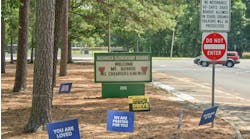Five years after the shooting deaths at Sandy Hook Elementary School in Newtown, Conn., many districts across the nation have taken steps to bolster security.
The Associated Press says the renewed emphasis on campus security has been especially noticeable at the elementary level, which traditionally have not had police assigned to them.
Many have hired retired officers, firefighters and other responsible adults — an approach that’s less expensive and potentially less intrusive than assigning sworn police, but one that also has raised questions about the consistency of training and standards.
Laws addressing requirements for school safety officers vary from state to state, and many leave it entirely up to local school boards.
In Danbury, Conn., which began posting security guards inside elementary schools after the Sandy Hook shooting, Mayor Mark Boughton pushed for state legislation that would have established standards and training for non-police security personnel. The bill ultimately did not pass.
Even before the shooting, security officers who were once almost exclusively at high schools before becoming common at middle schools also had been turning up increasingly at elementary schools, says Ronald Stephens, director of the National School Safety Center.
According to the National Center for Education Statistics, the percentage of primary U.S. public schools with one or more security staffer present at least once a week rose slightly from 26.2 percent in the 2005-2006 school year to 28.6 percent in 2013-2014.
In New Canaan, Conn., the school district contracted with a private company to set up campus monitors soon after the Newtown school shooting on Dec. 14, 2012.
The monitors report to the Board of Education, which also provides training. The monitors earn an average salary of $30,700, compared with $90,472 for police assigned as school resource officers.
The rise in the number of districts turning to private security has led to calls elsewhere to impose standards for school guards, particularly in cases where school boards allow for them to be armed.
In New Jersey, a law passed last year establishes a special class of law enforcement officers providing school security. The measure was sought by the New Jersey State Association of Chiefs of Police to encourage minimum training standards.
In Arkansas, a law passed in 2015 sets minimum training requirements on topics including active-shooter training and limitations on the authority of school security officers, according to the National Conference of State Legislatures.
Michele Gay, whose daughter was killed at Sandy Hook and who now works with school districts as a security advocate, says the ideal scenario would be to have an officer in every school, playing an all-purpose role similar to a school nurse. Where that’s not possible, she said the guards should at least be former police.
“We want everybody to be on the same page and have the same level of experience,” she says.
At New Canaan’s West Elementary, a guard greets students at the bus before making rounds to make sure doors and windows are locked. He monitors video feeds to watch people approaching the school and checks visitors’ identification. On occasion, the principal asks him to keep an eye out for parents who may be upset about something. A New Canaan police officer also comes by the school periodically and talks with student as part of a new program to build relationships with school staff.


